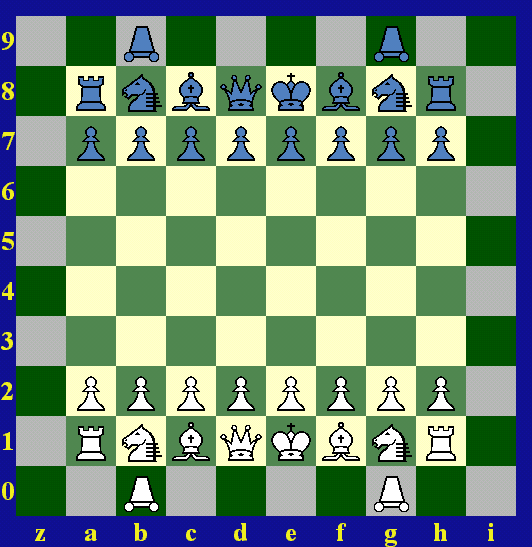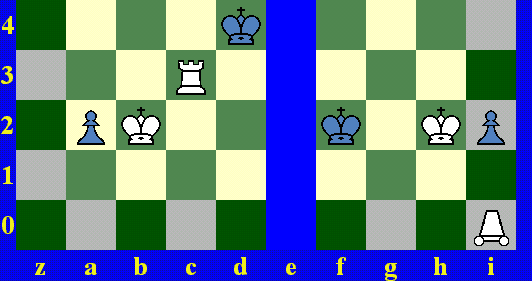Jumping Knights Chess
This chess variant is based on Peter Aronson's contest winning game Jumping Chess, in particular his notes to Subvariant (6). Knights have been replaced by Nightriders, which are better suited to a game where capture is accomplished by landing on a piece and continuing the move on to an empty square. War Machines (also called Scouts) have also been added to the initial setup.
Jumping Knights Chess is first of all a "chess variant", with priority given to check. [Rule 4], which I believe to be original to this game, is part of this philosophy. "Jumping" is the second key ingredient, requiring a larger board with special rules limiting movement to the 36 edge squares.
Setup

Pieces





These are the usual chess pieces, subject to the unusual rules of this chess variant.

The Nightrider repeats the Knight's leap along a straight line. It may continue leaping like a Knight in one direction until it is blocked from further leaping.

The War Machine moves 1 square orthogonally or leaps 3 squares orthogonally. When Greg Strong introduced this piece, as the Scout, he gave it an initial Knight move to speed the game up. See Brouhaha and Hubbub.
Rules
A game of Jumping Knights Chess must end when the player (whose turn it is) has no legal moves. The game result is then determined by the written rules below. Every one of my "SHATRANJ" variants has a stalemate victory rule, allowing stalemate draws in exceptional circumstances. This chess variant has a stalemate draw rule, allowing stalemate wins in exceptional circumstances.
Castling is allowed, with the King still moving two squares toward the Rook. Pawns can move two squares forward on their first move only, subject to "en passant" capture. White Pawns can and must promote to any piece of the same color (except a King or a Pawn) on rank 8 or 9. A White Pawn can only reach rank 9 by making a capture when it is on rank 7. Similar rules for Black Pawns. Promotion is not limited in any other way, one player may have up to 9 Queens on the board.
[Rule 1] Checkmate is a win. Kings are never captured and it is illegal to leave your King in check or to make a move causing your King to be checked. "Check" involves the threat of capture, as defined in Rule 3.
[Rule 2] Stalemate is usually a draw. You can win by stalemating your opponent, if your King is on one of the central 64 squares and your opponent has at least one piece on the edge of the board.
[Rule 3] Noncapturing moves must end on one of the 64 central squares. Every capturing move in this game involves hopping over the captured piece to an empty square. See Jumping Chess for examples, with many diagrams. A Ferz would capture one of the opponent's pieces in exactly the same way as in Checkers/Draughts. Multiple captures are not allowed in this game. A more "chess-like" way of stating the capture rule is: make a traditional Ferz capture and then continue one square further in the same direction (ending your move on an empty square). A Ferz capture always ends an Alfil jump away from its starting square. Pawns make Ferz captures, but only forward. The Bishop captures in a similar manner to the Ferz, moving at least one square towards the captured piece and continuing at least one square further in the same direction. The continuation does not have to be the same distance as the capture.
A Wazir capture is the orthogonal equivalent of a Ferz capture. A Wazir capture always ends an Dabbabah leap away from its starting square. The Rook and the War Machine capture in a similar manner to the Wazir, but with the option of moving greater distances. The continuation does not have to be the same distance as the capture.
The King can capture [1] like a Ferz or [2] like a Wazir, subject to the limitations placed on a royal piece. The Queen can capture [1] like a Bishop or [2] like a Rook. The Nightrider makes one or more Knight-leaps to the piece it is capturing and then continues on in the same direction with one or more Knight-leaps to an empty square.
[Rule 4] When at least one of your pieces on the edge of the board has a legal capture that takes it off the edge of the board, you are required EITHER to make such a capture OR to give check to your opponent's King.
[Rule 5] Other standard chess rules apply: including draws by threefold repetition of position and the 50 moves rule. Two Separate Endgame Positions (below) show that we cannot immediately say that the game is a draw when only the two Kings remain on the board.
Sample Game, showing some legal moves: 1.Pawn g2-g3 Nightrider g8xd2-c0 check 2.War Machine b0xc0-f0 Pawn d7-d5 3.Bishop f1-g2 Pawn c7-c6 4.Queen d1xd5-d7 check Queen d8xd7-d1 check and now 5.King e1-f1 is the only legal move.

Two Separate Endgame Positions
White: King(b2), Rook(c3) and Black: King(d4), Pawn(a2). Promoting the Pawn with 1... a2-a1 (Q) leads to a draw in FIDE Chess and a Black win in Jumping Knights Chess. If White captures the Queen, landing on (z0), then Black captures the Rook, landing on (b2), and has a stalemate victory by Rule 2. Instead of capturing the Queen, White can try this line 2.Kb2-c2 Qa1-a2 check 3.Kc2-c1 Qa2-c2 checkmate.
White: King(h2), War Machine(i0) and Black: King(f2), Pawn(i2). The War Machine will never move, as there is nothing for it to capture. The Pawn will never move, as no White piece will ever enter (h1). The two Kings will wander aimlessly about the central 64 squares until the game is called a draw. In general, Pawns on edge squares are trapped unless a capturing move presents itself, while Rooks and War Machines on corner squares are similarly trapped. In all cases any noncapturing move would land the piece on another edge square, which is forbidden to noncapturing moves. Other pieces can usually manage to escape back to the central 64 squares.
Notes
PROBLEM: Using your King and any two pieces, defeat the lone King. Dave McCooey writes that King and Nightrider and Knight can force checkmate, in general. So can a King and two Nightriders. The highly unusual case of King and two Bishops (on the same color squares) cannot end in a legal checkmate. But Jumping Knights Chess has its own tactics. Consider the position with White: King(c2), Bishop(d2), Bishop(c5) and Black: King(a1). Now:
1.Bd2-c3 check Ka1-a2 2.Bc3-a1 Ka2-a0 (capturing the Bishop) 3.Bc5-d4 stalemate victory.
Bishop and War Machine seem to have similar values. So do Rook and Nightrider. A Queen may still be worth a little more than Rook and Bishop together. Lacking practical experience in this game, I cannot hope to estimate piece values more accurately than this. [April 2023 UPDATE] Added the diagram above showing the start and finish of this Two Bishops problem (top four ranks of the board are cut off). Still limiting my playtesting to a few Shatranj variants.
 This 'user submitted' page is a collaboration between the posting user and the Chess Variant Pages. Registered contributors to the Chess Variant Pages have the ability to post their own works, subject to review and editing by the Chess Variant Pages Editorial Staff.
This 'user submitted' page is a collaboration between the posting user and the Chess Variant Pages. Registered contributors to the Chess Variant Pages have the ability to post their own works, subject to review and editing by the Chess Variant Pages Editorial Staff.
By David Paulowich.
Last revised by David Paulowich.
Web page created: 2007-05-21. Web page last updated: 2007-05-21
